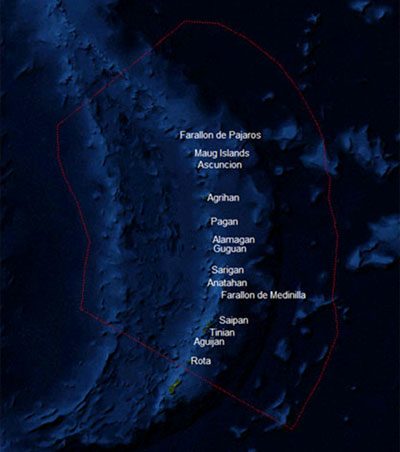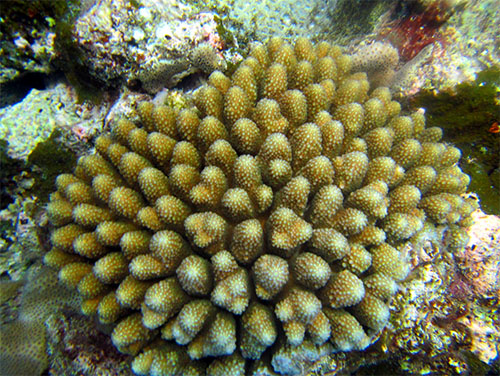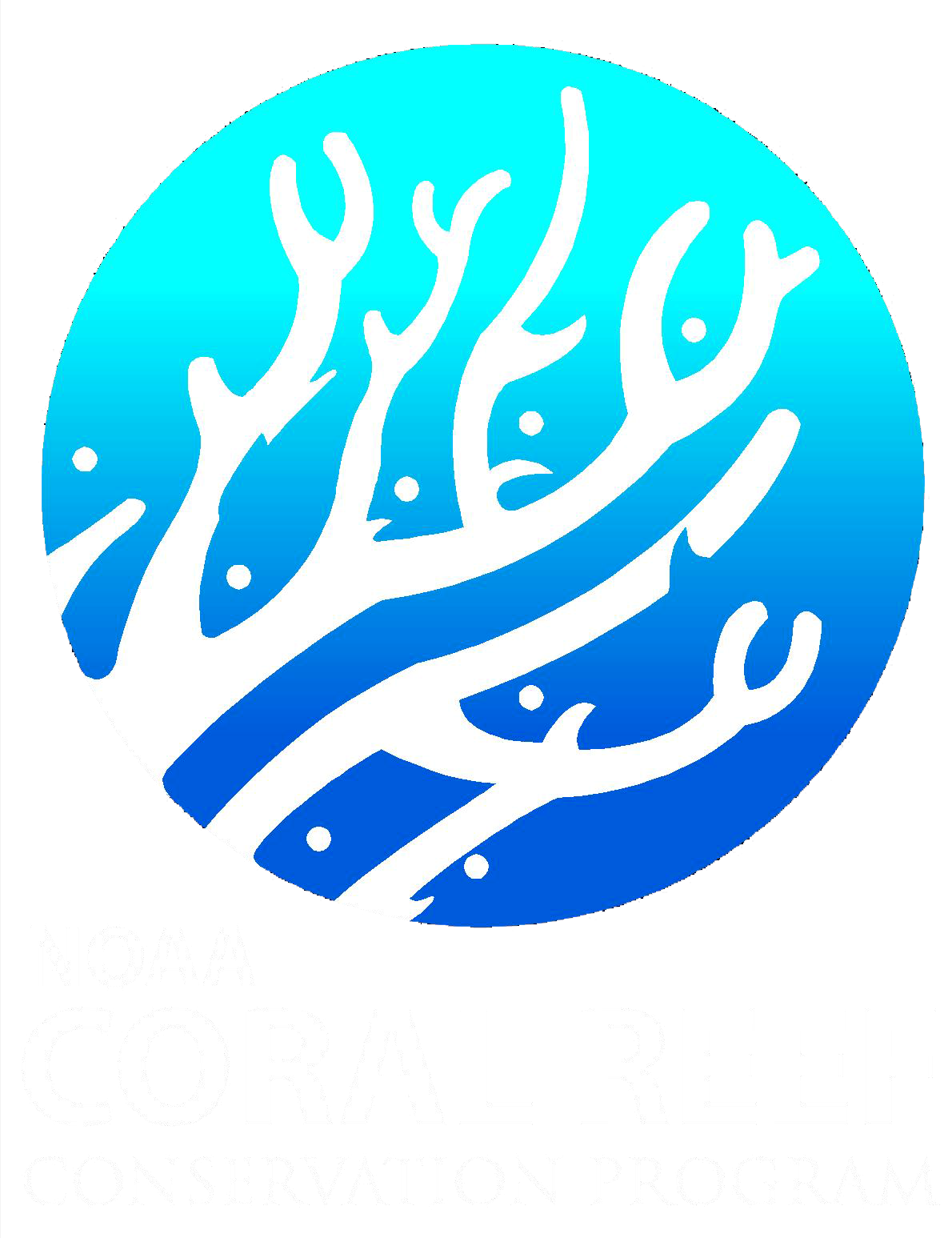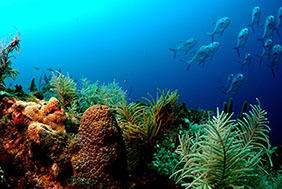-
Home
-
Data & Publications
-
Regional Portals
- About Regional Portals
- Florida
- Navassa Island
- Puerto Rico
- Flower Garden Banks
- U.S. Virgin Islands
- American Samoa
- Commonwealth of the Northern Mariana Islands
- Federated States of Micronesia
- Guam
- Main Hawaiian Islands
- Republic of the Marshall Islands
- Northwestern Hawaiian Islands
- Republic of Palau
- Pacific Remote Island Areas
-
CRCP Activities
- Glossary
Commonwealth of the Northern Mariana Islands (CNMI)
Located just north of Guam in the western Pacific, the Commonwealth of the Northern Mariana Islands is a three-hundred mile archipelago consisting of 14 islands, with a total land area of 183.5 square miles. The principal inhabited islands are Saipan, Guguan, Rota and Tinian. The northern, largely uninhabited islands are Farallon de Medinilla, Anatahan, Sariguan, Gudgeon, Alamagan, Pagan, Agrihan, Asuncion, Maug Islands, and Farallon de Pajaro. Saipan is approximately 3,300 miles west-southwest of Honolulu and 3000 miles north of Sydney. The majority of the CNMI's residents live on Rota, Tinian, and Saipan, the capital and largest of the Northern Mariana Islands.
The Mariana Islands are on the edge of the Philippine Plate. They were formed by underwater volcanoes along the Marianas Trench. The northern islands are high volcanic islands and the southern islands, while volcanic in origin, are capped by uplifted limestone derived from coral reefs. The southern islands have the oldest and most developed reefs in the CNMI, which are predominantly located along the western (leeward) sides.
Saipan has the most diverse types of coral reefs and associated habitats in the CNMI. A fringing and barrier reef system protects the majority of the beaches along the western side of the island, forming a 12.4 square mile shallow-water lagoon system. This environment contains large assemblages of seagrass, branching corals, and the last remaining mangroves in the CNMI. The western side of the island is the most populated and the coral reefs along these areas are negatively affected by human activity. Continuing sediment and nutrient pollution, combined with sporadic stressors such as outbreaks of crown-of-thorns starfish (COTS) and bleaching, affect many of Saipan's western and southeastern reefs. These impacts are compounded by an expanding tourism industry and direct damage from heavy visitor use.
Coral reef ecosystems in the CNMI are, on the whole, reasonably healthy. However, environmental stressors acting along with anthropogenic stressors, such as nonpoint source pollution and fishing pressure, have clearly affected areas in proximity to the populated southern islands. From a fisheries perspective, the northern islands and more distant banks and reefs appear to be in better condition than those closer to population centers.

Commonwealth of the Northern Mariana Islands location map

Northern Mariana Islands satellite map
Highlights
OCM Coastal Impact Stories: Coral Reef Conservation Program in CNMI
Coral Reef Condition: A Status Report for the Commonwealth of the Northern Mariana Islands (2018)
NCCOS Assessment: Benthic Habitat Maps of Saipan Lagoon (2017)
Publications
CNMI's Coral Reef Management Priorities (2010)
CNMI Capacity Assessment Report and Coral Reef Conservation Timeline
Coral Reef Ecosystem Monitoring Report of the Mariana Archipelago: 2003-2007
Transport Pathways of Marine Larvae Around the Mariana Archipelago
Potential larval sources, destinations, and self-seeding in the Mariana Archipelago documented using ocean drifters (Journal of Oceanography, 2014)
Environmental factors affecting large-bodied coral reef fish assemblages in the Mariana Archipelago. PLoS ONE. doi: 10.1371/journal.pone.0031374
Western Pacific Archipelagic Fishery Ecosystem Annual Report for 2012
Report on the Status of Marine Protected Areas in Coral Reef Ecosystems of the United States. Volume 1: Marine Protected Areas Managed by U.S. States, Territories, and Commonwealths. NOAA Technical Memorandum CRCP 2 February 2007
Validation of Reef-Scale Thermal Stress Satellite Products for Coral Bleaching Monitoring. doi:10.3390/rs8010059
Shift from coral to macroalgae dominance on a volcanically acidified reef Nature Climate Change. doi:10.1038/nclimate2758
The Micronesia Challenge: Assessing the Relative Contribution of Stressors on Coral Reefs to Facilitate Science-to-Management Feedback. PloS one. doi: 10.1371/journal.pone.0130823
Field Identification Guide to the Threatened Corals of the U.S. Pacific Islands

A colony of A. globiceps from Rota. Copyright Douglas Fenner.
Status Report
Coral Reef Condition: A Status Report for the Commonwealth of the Northern Mariana Islands (2018)
State of The Reefs Report (SOTR)
The State of Coral Reef Ecosystems of the United States and Pacific Freely Associated States: 2008.
The State of Coral Reef Ecosystems of the United States and Pacific Freely Associated States: 2005.
The State of Coral Reef Ecosystems of the United States and Pacific Freely Associated States: 2002.
Local Action Strategy
CNMI Local Action Strategy Factsheet
Watershed Management Plans
Laolao Bay Conservation Action Plan (2009)
Talakhaya/Sabana Conservation Action Plan
Metadata, Data and Publications Search in CoRIS
Search the CoRIS Geoportal for Commonwealth of the Northern Mariana Islands metadata, data and publications
ReefBase Coral Bleaching Reports
Select "Micronesia" in the Region window and "Northern Mariana Islands" in the Country window.
Near-Real Time Data
Coral Reef Watch Satellite Monitoring
Coral Reef Watch - Mariana Islands and Guam Virtual Stations
The Global Temperature-Salinity Profile Program
USGS Water Resources - Data for the Northern Mariana Islands
NOAA CO-OPS - Tide Data
NOAA Tidal Predictions - Northern Marianas Islands
Other Data
CNMI Coastal and Marine Spatial Planning Data Portal
NCCOS Assessment: Benthic Habitat Maps of Saipan Lagoon (2017)
Pacific Islands Benthic Habitat Mapping Center - CNMI data
Guam and the Northern Mariana Islands Environmental Sensitivity Index (ESI) Atlas
Coastal Change Analysis Program (C-CAP) Land Cover Data - Commonwealth of the Northern Mariana Islands
USGS Projected Flood Extent for the Commonwealth of the Mariana Islands
CNMI Division of Coastal Resources Management GeoData and Publications website
Education and Outreach
CNMI Coral Reef Initiative:
Coastal Resources Management Program
- DCRM Education & Outreach Program
- CNMI Watershed Management Program
- Promoting Conservation & Wise Use of Our Coastal Resources
CNMI Division of Fish & Wildlife - http://www.dfw.gov.mp/Monument_Page.html/
The World Factbook - Northern Mariana Islands
Marine Protected Areas and Wildlife Conservation Areas
Marine Protected Areas of the United States Home Page
The Marine Protected Areas Inventory
Marine Federal Areas Fact Sheet
Executive order 13158: Marine Protected Areas


